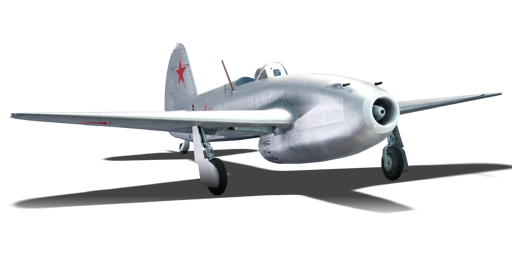



The Yak-15 was one of the first attempts by the Soviet Union to produce a jet-engined fighter. Development started at the end of WWII, and to reduce development time, it was decided to use the existing airframe of the Yak-3 piston fighter and adapt a reverse-engineered German Junkers Jumo 004 engine. It was developed alongside the MiG-9 and it's still disputed to this day which of the two was the true first jet fighter of the USSR. Compared to its aforementioned competitor, the Yak-15 was easier to fly thanks to being designed on the basis of the Yak-3, many pilots already knowing how to fly the plane. A total of 280 units were built until 1947, and it was specially used to adapt old piston fighter pilots to fly jet-engined fighters.
It was introduced in Update 1.31. The Yak-15 suffers from the poor engine in early jets. This, and the fact that it usually fights late prop fighters with very powerful piston engines, makes this jet hard to master for noob pilots. However, it still has the airframe of the Yak-3. This makes the Yak-15 a very nimble and agile fighter capable of pulling extreme manoeuvres and very tight turns. The most important obstacles to overcome are the low ammo pool (60 rounds per gun) and the very weak engine with just 850 kgf when stock. To survive, it is important to climb and stay outside of fights without allied help. In 1v1 situations, the jet engine in the Yak-15 will make it lose less energy in turns compared to piston fighters; however, regaining lost speed back is harder and takes more time, so having altitude that can easily be converted to energy is important
flaps
flaps
flaps
brake
| Belt | Belt filling | Armor penetration (mm) at a distance: | |||||
|---|---|---|---|---|---|---|---|
| 10 m | 100 m | 500 m | 1000 m | 1500 m | 2000 m | ||
| AP-I/FI-T | 32 | 30 | 22 | 15 | 10 | 7 | |
| FI-T/AP-I/AP-I/AP-I | 32 | 30 | 22 | 15 | 10 | 7 | |
| FI-T/FI-T/FI-T/AP-I | 32 | 30 | 22 | 15 | 10 | 7 | |
| AP-I | 32 | 30 | 22 | 15 | 10 | 7 | |












Flight performance | |
|---|---|
Survivability |
|---|
Weaponry |
|---|